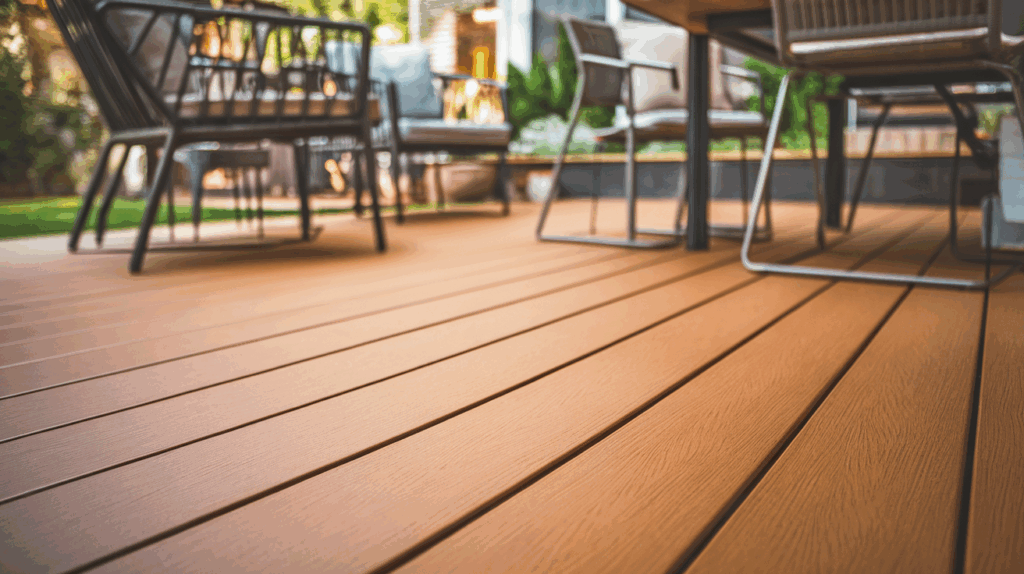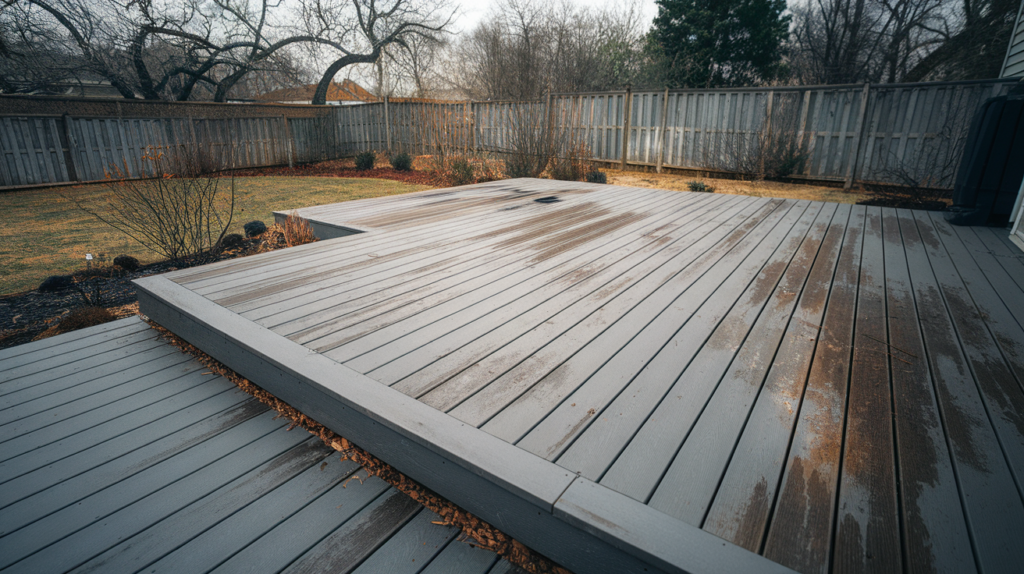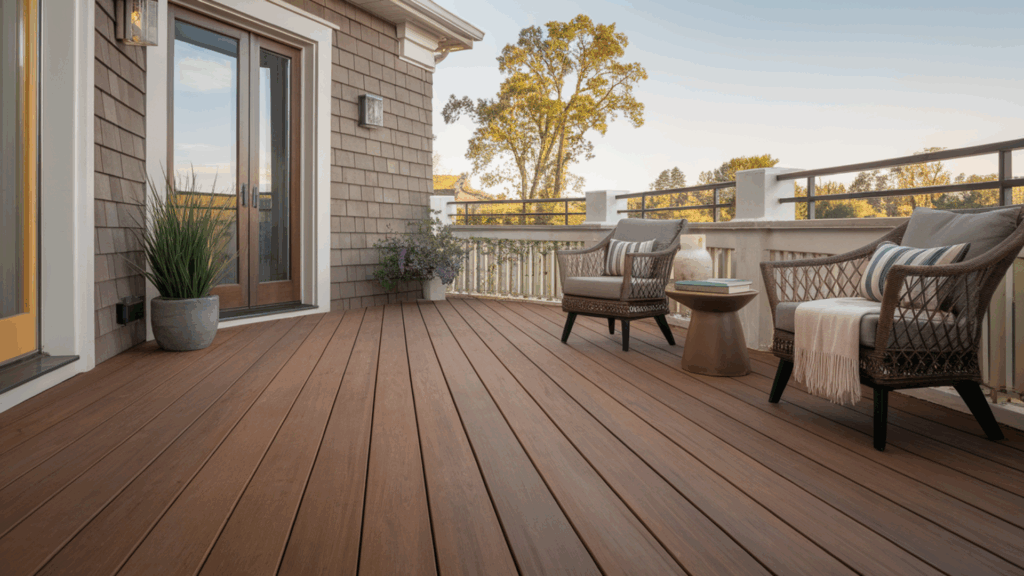Composite decking has rapidly become a popular alternative to traditional wood boards for outdoor spaces. Made from a mix of wood fibers and recycled plastic.
These boards promise durability and low maintenance for homeowners looking to create beautiful patios and decks. But is it really the perfect solution?
While many people love composite decking for its sleek appearance and long-lasting properties, it’s not without serious drawbacks.
My guide will walk you through critical disadvantages that manufacturers won’t tell you about.
My goal isn’t to discourage you, but to help you make a smart, informed decision about your outdoor living space.
I understand choosing decking materials is a big investment. By the end of this blog, you’ll have clear insights to select the right option for your home confidently.
What Is Composite Decking?

Composite decking is a man-made material used for building decks.
It’s made from a mix of wood fibers and plastic, which are pressed together to form strong, weather-resistant boards.
Unlike real wood, composite decking won’t rot, splinter, or require painting or staining.
It comes in many colors and styles, making it easy to match your outdoor space. It’s a great low-maintenance option for busy homeowners.
Disadvantages of Composite Decking
Composite decking may seem perfect, but I’ve found that it does have some downsides. In this section, I’ll walk you through the honest truths that many manufacturers don’t often talk about:
1. Higher Upfront Cost
Composite decking might make your wallet wince. While traditional wood planks cost around $10-$20 per square foot, composite materials can set you back $30-$60 per square foot.
That’s nearly triple the price! The initial investment is steep, making homeowners think twice before committing to this modern decking option.
2. It Can Get Too Hot in the Sun
Walking barefoot on a composite deck during summer can feel like stepping on a frying pan. Unlike wood, these materials absorb and retain heat intensely.
On a blazing hot day, surface temperatures can reach 150°F, making it impossible to walk without shoes. Beach houses and sunny patios beware!
3. Looks Less Natural than Real Wood
Despite manufacturers’ best efforts, composite decking often looks artificial. The repeated patterns and uniform texture scream “manufactured” instead of natural.
Wood grain enthusiasts will immediately spot the difference.
No matter how advanced the technology, it struggles to replicate the authentic, organic feel of real wooden planks.
4. Color Fading Over Time
Sunlight is a composite deck’s worst enemy. Within a few years, those vibrant colors start to wash out.
What began as a rich, deep tone can quickly become a pale, washed-out version of its original self.
UV rays break down the color pigments, leaving your deck looking tired and aged.
5. Surface Scratches Easily
Composite decks aren’t as tough as they appear. Dragging patio furniture, pet claws, or even high heels can leave noticeable marks.
Unlike wood, which can be sanded smooth, these scratches are permanent. Your pristine new deck can start looking worn out much faster than you’d expect.
6. Heavier than Wood
Composite boards are significantly heavier than traditional wooden planks. This extra weight makes DIY installation challenging.
Homeowners attempting a self-install will find these materials more difficult to maneuver, potentially requiring extra hands or professional help.
The weight can also stress underlying structures more than lighter wood.
7. Slippery when Wet or Icy
Safety becomes a serious concern with composite decking. These surfaces turn into skating rinks when wet or icy.
Rain, morning dew, or winter conditions can create dangerous slip hazards.
Some brands are worse than others, but most composite materials struggle with providing reliable traction.
8. Can Attract Mold and Mildew
Contrary to popular belief, composite decks aren’t immune to organic growth. Shady areas and humid climates become breeding grounds for mold and mildew.
These stubborn spots can discolor your deck and require specialized cleaning solutions. Regular maintenance becomes crucial to keep your deck looking clean.
9. Prone to Staining
Spill a glass of red wine or drop some grease during a barbecue, and you’ll face a nightmare. Composite decks absorb stains more readily than wood.
Grease, oil, and certain foods can leave permanent marks. Cleaning becomes a constant battle to preserve your deck’s appearance.
10. Difficult to Repair
Damaged a board? With wood, you could sand or replace a single plank. Composite decking offers no such luxury.
Damaged sections often require complete board replacement, which can be expensive and challenging to color-match. A single scratch might mean replacing an entire section.
11. It May Expand and Contract
Temperature changes cause composite boards to move. Hot days make them expand; cold days cause contraction.
This constant movement can lead to gaps, warping, and potential structural issues.
Homeowners in regions with significant temperature variations will find this particularly frustrating.
12. Special Fasteners Often Needed
Forget standard wood screws. Composite decking demands specialized fasteners, adding complexity and cost to installation.
These unique clips and hidden fastener systems increase overall project expenses and require more precise installation techniques. DIY enthusiasts might find this particularly challenging.
13. Not Fully Maintenance-Free
Marketing might promise zero maintenance, but that’s far from true. Composite decks need regular cleaning to prevent dirt buildup, mold growth, and staining.
Specialized cleaners, periodic washing, and careful maintenance are still required to keep your deck looking good.
14. Some Brands Feel Cheap or Plastic-Like
Quality varies dramatically between manufacturers. Some composite decking feels more like walking on a plastic surface than a natural deck.
The texture can be uncomfortably synthetic, making your outdoor space feel less inviting and more artificial.
15. Limited Color Change Options
Want to refresh your deck’s look? With composite, you’re mostly out of luck.
Unlike wood, which can be sanded and restained, these materials offer minimal color modification. What you choose initially is what you’re stuck with for the deck’s lifetime.
16. May Lower Resale Appeal
Traditional homebuyers might view composite decking skeptically. Some prefer the classic look of real wood, potentially impacting your home’s resale value.
Certain buyers see composite as a cheaper, less authentic alternative to traditional wooden decks.
17. Not as “green” as It Seems
Marketed as an eco-friendly option, composite decking isn’t necessarily environmental.
Made from mixed plastics and wood fibers, these materials aren’t easily recyclable.
The manufacturing process itself can be resource-intensive, challenging its green credentials.
Ways to Fix or Reduce Composite Deck Issues

Choosing composite decking doesn’t mean you’re stuck with its limitations. I’ll share smart strategies to overcome common challenges, helping you maximize performance and minimize frustration.
1. Research Brands Carefully
Not all composite decking is created equal. I’ve learned this the hard way. Some brands offer better UV protection and durability than others.
Spend time reading reviews, checking warranties, and comparing product specifications. The extra research can save you thousands in future headaches.
2. Strategic Installation Matters
Location is everything. If you’re dealing with a hot climate, consider partial shade or strategic placement.
Deck placement can make or break your experience. Install near trees or use pergolas to reduce direct sunlight. Think of it like sunscreen for your deck.
3. Invest in Quality Protective Gear
Rugs aren’t just for indoor spaces. Use outdoor rugs and furniture pads to minimize scratches and wear.
These simple additions can protect high-traffic areas and extend your deck’s life. Look for materials specifically designed for outdoor use.
4. Develop a Consistent Cleaning Routine
Maintenance isn’t zero, but it’s close. Create a simple cleaning schedule. Use manufacturer-recommended cleaners. Avoid harsh chemicals.
A quick wash every few months prevents mold, mildew, and stain buildup. Think of it like brushing your teeth – fast, easy, and it prevents bigger problems.
5. Temperature Management Tricks
Hate a hot deck? Some solutions are genius. Light-colored boards absorb less heat.
Consider partial shade structures. Outdoor fans can help. On scorching days, keep a spray bottle handy to cool down the surface quickly.
6. Understand Your Specific Environment
Climate is key. Humid areas need different care than dry regions. Coastal zones have salt considerations.
Mountain environments have temperature swings. Talk to local deck professionals who understand your specific environment.
7. Protect Against Potential Damage
Furniture with smooth feet. Rubber protectors. Regular inspections. These small steps prevent major issues.
Think preventative medicine, but for your deck. Catch potential problems before they become expensive repairs.
8. Budget for Potential Replacements
Even high-quality composite decks might need partial replacements. Set aside a small maintenance fund.
It’s like an insurance policy for your outdoor space. Unexpected doesn’t mean unprepared.
9. Learn Proper Installation Techniques
If you’re a DIY enthusiast, learn proper techniques. Incorrect installation amplifies composite decking’s drawbacks.
Watch manufacturer videos. Attend workshops. Knowledge is your best tool.
10. Consider Hybrid Solutions
Some brands offer hybrid materials. These combine the best of wood and composite. They might cost more but offer unique benefits.
Think of it like a performance hybrid car – the best of both worlds.
Alternatives to Consider: Wood, PVC, or Hybrid Options
When I started my deck research, I realized composite isn’t the only game in town. This is a straightforward breakdown to help you make the best choice for your outdoor space.
| Material | Pros | Cons | Best For |
|---|---|---|---|
| Natural Wood |
Lowest upfront cost, Classic, authentic look, Easy to repair |
High maintenance, Splinters, Rots over time | Budget-conscious homeowners who love traditional looks |
| Cedar/Redwood | Natural beauty, naturally resistant to decay, smells great | Expensive, requires regular sealing, fades quickly | Homeowners wanting a premium natural look |
| Pressure-Treated Wood | Most affordable, Widely available, Resists insects | Chemical treatments, Prone to warping, Rough texture | DIY enthusiasts on a tight budget |
| PVC Decking | Lightest material, Cooler in sunlight, Zero wood content | Most expensive, can look artificial, Less eco-friendly | Those in hot climates want a cooler surface |
| Hybrid Materials | Better heat resistance, More natural look, Improved durability | Mid-range pricing, Limited color options, and still developing technology | Homeowners seeking a balance between performance and aesthetics |
Conclusion
This material isn’t magical. It’s just another option with serious pros and serious cons.
I’ve walked you through the landscape of potential challenges, from heat issues to installation complexities.
Your deck, your choice.
Some homeowners will love composite. Others will hate it. The key is understanding your specific needs. Climate matters. Budget matters. Lifestyle matters.
Don’t get trapped by marketing hype. Real-world performance trumps promises. Some brands excel while some disappoint. Research is your best friend.
Remember that there’s no perfect material, only the best fit for you. Your outdoor space should reflect your life, not some manufacturer’s sales pitch.
Choose wisely, measure twice, and install once.
Your dream deck is waiting.

